Research Methods for Tourism, Hospitality and Events
VerifiedAdded on 2023/01/09
|9
|1855
|33
AI Summary
This document provides information on research methods for the fields of tourism, hospitality, and events. It includes an interview checklist, research diary extract, visual analysis, and an introduction to sustainability in the fashion retail industry. The document also includes references for further reading.
Contribute Materials
Your contribution can guide someone’s learning journey. Share your
documents today.
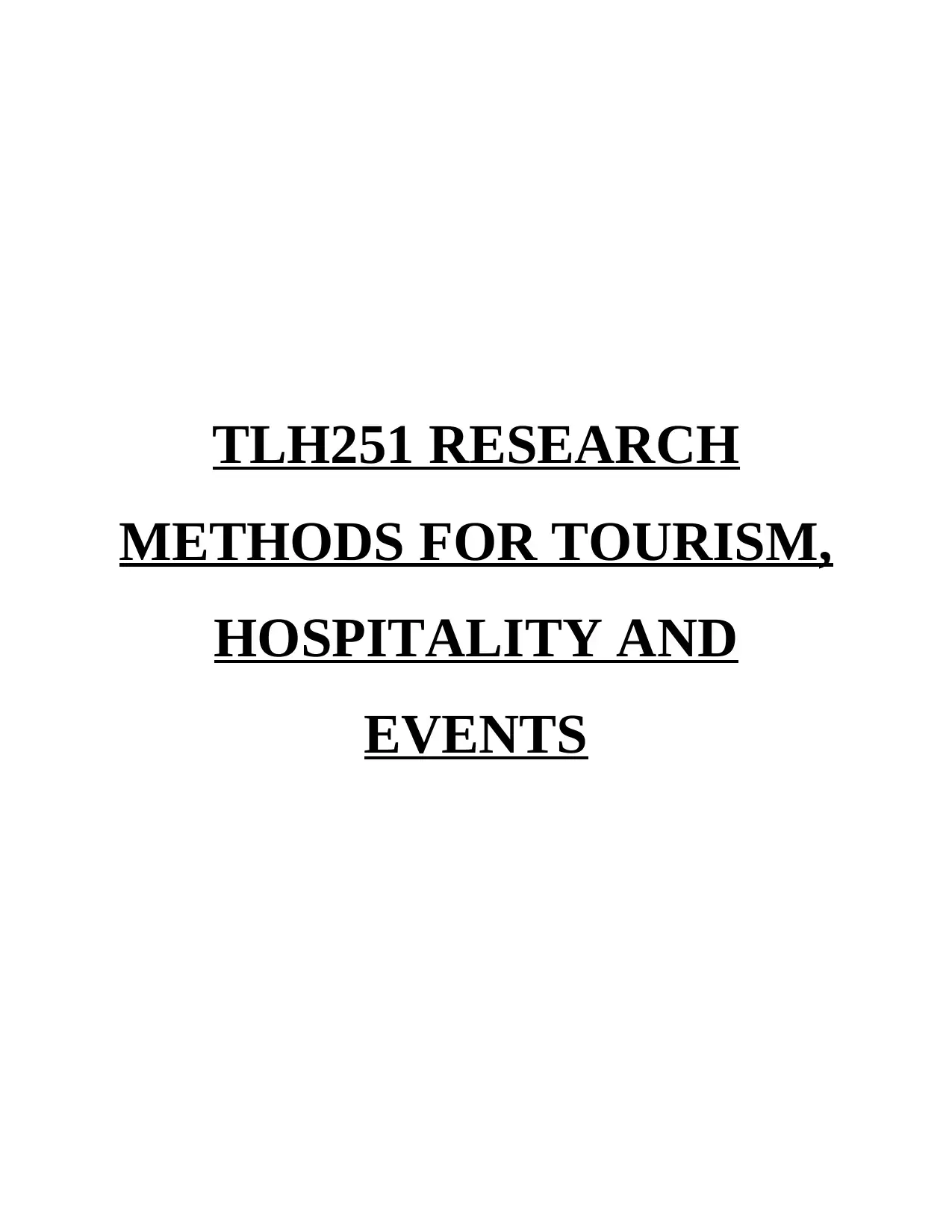
TLH251 RESEARCH
METHODS FOR TOURISM,
HOSPITALITY AND
EVENTS
METHODS FOR TOURISM,
HOSPITALITY AND
EVENTS
Secure Best Marks with AI Grader
Need help grading? Try our AI Grader for instant feedback on your assignments.
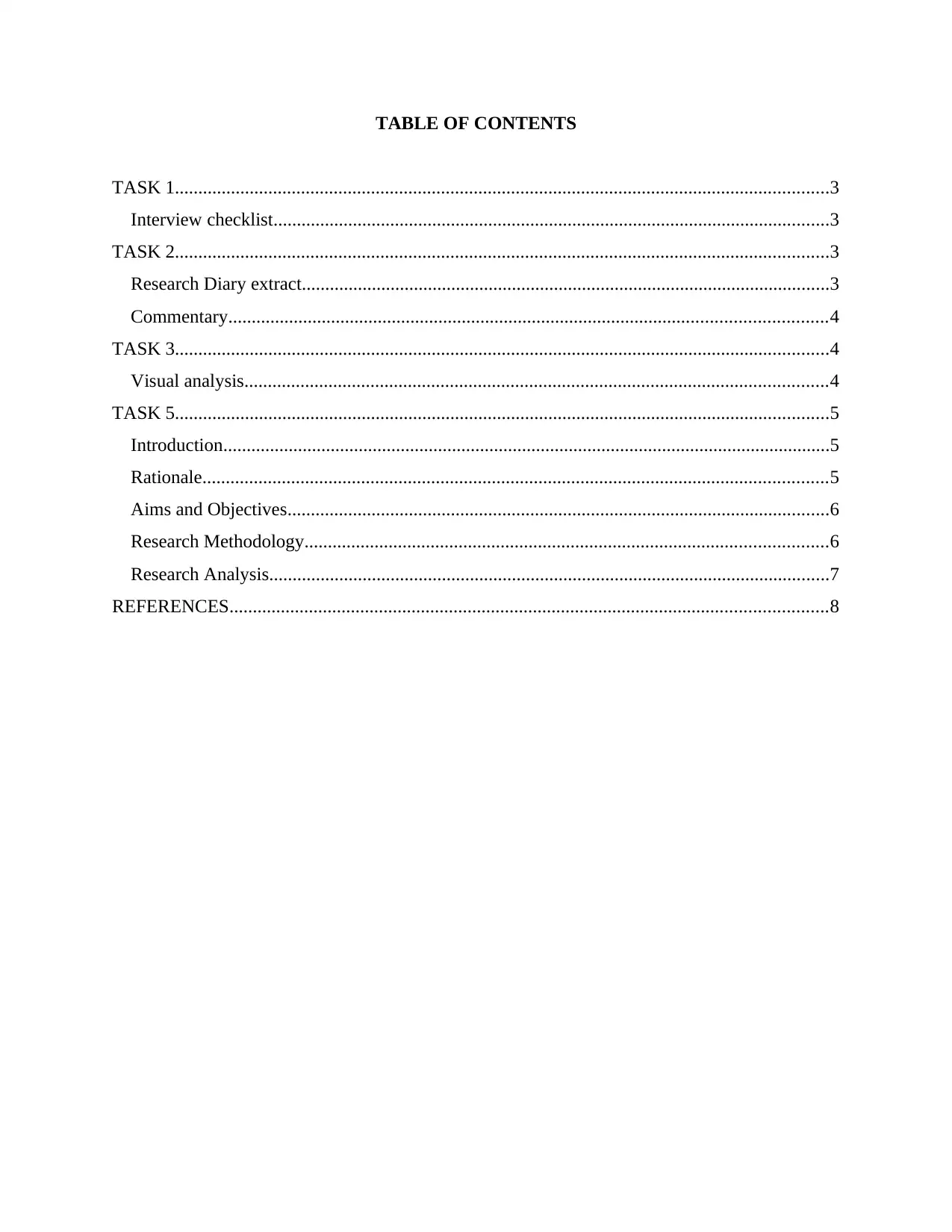
TABLE OF CONTENTS
TASK 1............................................................................................................................................3
Interview checklist.......................................................................................................................3
TASK 2............................................................................................................................................3
Research Diary extract.................................................................................................................3
Commentary................................................................................................................................4
TASK 3............................................................................................................................................4
Visual analysis.............................................................................................................................4
TASK 5............................................................................................................................................5
Introduction..................................................................................................................................5
Rationale......................................................................................................................................5
Aims and Objectives....................................................................................................................6
Research Methodology................................................................................................................6
Research Analysis........................................................................................................................7
REFERENCES................................................................................................................................8
TASK 1............................................................................................................................................3
Interview checklist.......................................................................................................................3
TASK 2............................................................................................................................................3
Research Diary extract.................................................................................................................3
Commentary................................................................................................................................4
TASK 3............................................................................................................................................4
Visual analysis.............................................................................................................................4
TASK 5............................................................................................................................................5
Introduction..................................................................................................................................5
Rationale......................................................................................................................................5
Aims and Objectives....................................................................................................................6
Research Methodology................................................................................................................6
Research Analysis........................................................................................................................7
REFERENCES................................................................................................................................8
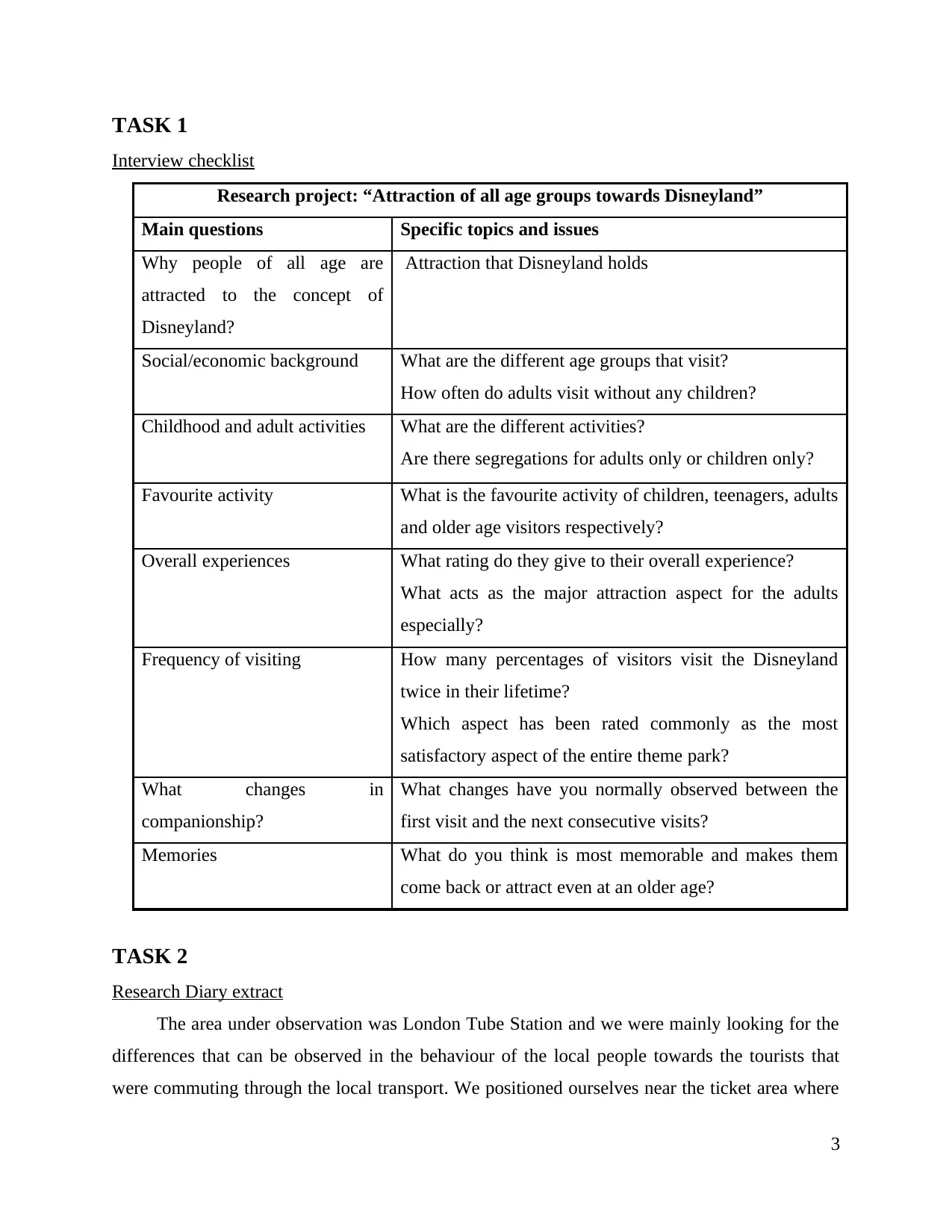
TASK 1
Interview checklist
Research project: “Attraction of all age groups towards Disneyland”
Main questions Specific topics and issues
Why people of all age are
attracted to the concept of
Disneyland?
Attraction that Disneyland holds
Social/economic background What are the different age groups that visit?
How often do adults visit without any children?
Childhood and adult activities What are the different activities?
Are there segregations for adults only or children only?
Favourite activity What is the favourite activity of children, teenagers, adults
and older age visitors respectively?
Overall experiences What rating do they give to their overall experience?
What acts as the major attraction aspect for the adults
especially?
Frequency of visiting How many percentages of visitors visit the Disneyland
twice in their lifetime?
Which aspect has been rated commonly as the most
satisfactory aspect of the entire theme park?
What changes in
companionship?
What changes have you normally observed between the
first visit and the next consecutive visits?
Memories What do you think is most memorable and makes them
come back or attract even at an older age?
TASK 2
Research Diary extract
The area under observation was London Tube Station and we were mainly looking for the
differences that can be observed in the behaviour of the local people towards the tourists that
were commuting through the local transport. We positioned ourselves near the ticket area where
3
Interview checklist
Research project: “Attraction of all age groups towards Disneyland”
Main questions Specific topics and issues
Why people of all age are
attracted to the concept of
Disneyland?
Attraction that Disneyland holds
Social/economic background What are the different age groups that visit?
How often do adults visit without any children?
Childhood and adult activities What are the different activities?
Are there segregations for adults only or children only?
Favourite activity What is the favourite activity of children, teenagers, adults
and older age visitors respectively?
Overall experiences What rating do they give to their overall experience?
What acts as the major attraction aspect for the adults
especially?
Frequency of visiting How many percentages of visitors visit the Disneyland
twice in their lifetime?
Which aspect has been rated commonly as the most
satisfactory aspect of the entire theme park?
What changes in
companionship?
What changes have you normally observed between the
first visit and the next consecutive visits?
Memories What do you think is most memorable and makes them
come back or attract even at an older age?
TASK 2
Research Diary extract
The area under observation was London Tube Station and we were mainly looking for the
differences that can be observed in the behaviour of the local people towards the tourists that
were commuting through the local transport. We positioned ourselves near the ticket area where
3
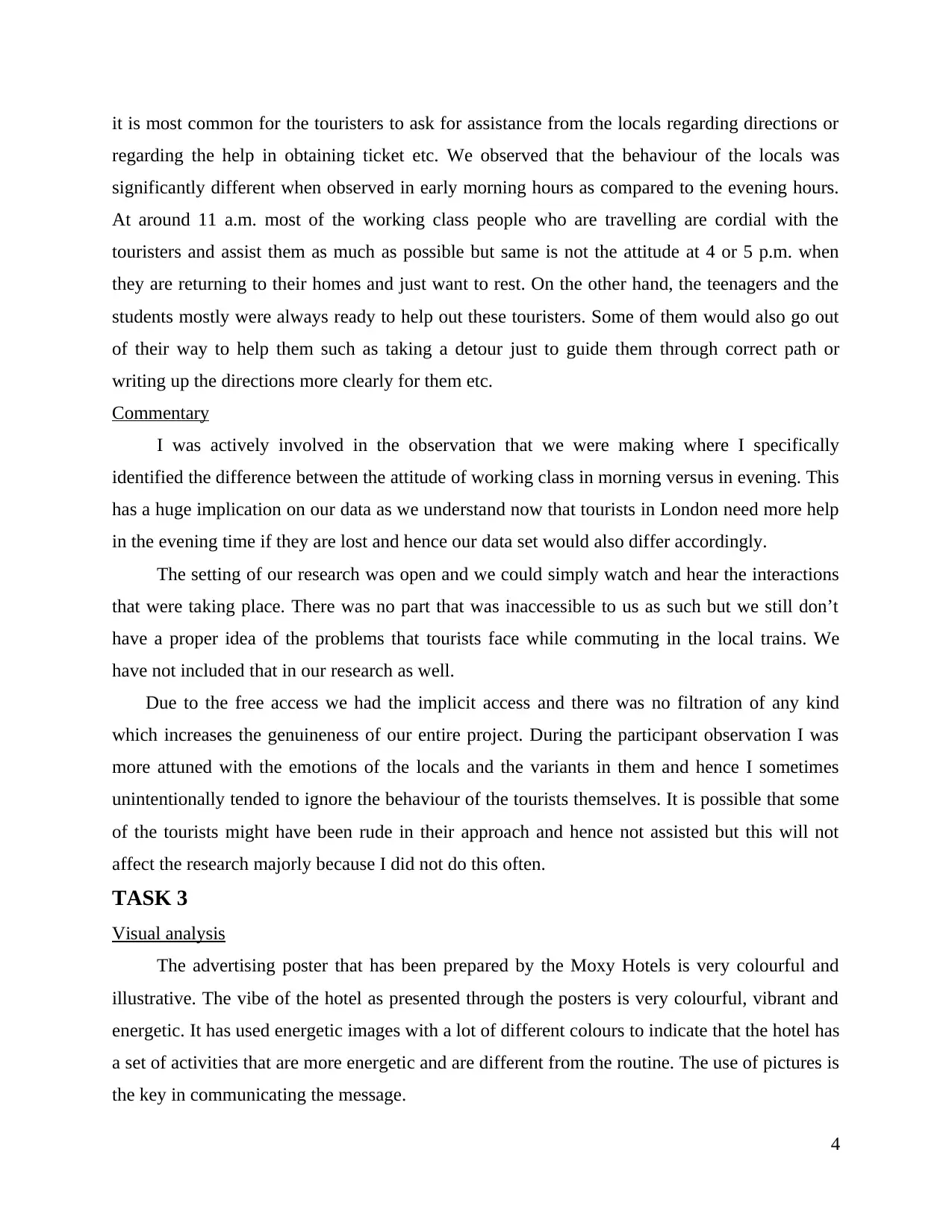
it is most common for the touristers to ask for assistance from the locals regarding directions or
regarding the help in obtaining ticket etc. We observed that the behaviour of the locals was
significantly different when observed in early morning hours as compared to the evening hours.
At around 11 a.m. most of the working class people who are travelling are cordial with the
touristers and assist them as much as possible but same is not the attitude at 4 or 5 p.m. when
they are returning to their homes and just want to rest. On the other hand, the teenagers and the
students mostly were always ready to help out these touristers. Some of them would also go out
of their way to help them such as taking a detour just to guide them through correct path or
writing up the directions more clearly for them etc.
Commentary
I was actively involved in the observation that we were making where I specifically
identified the difference between the attitude of working class in morning versus in evening. This
has a huge implication on our data as we understand now that tourists in London need more help
in the evening time if they are lost and hence our data set would also differ accordingly.
The setting of our research was open and we could simply watch and hear the interactions
that were taking place. There was no part that was inaccessible to us as such but we still don’t
have a proper idea of the problems that tourists face while commuting in the local trains. We
have not included that in our research as well.
Due to the free access we had the implicit access and there was no filtration of any kind
which increases the genuineness of our entire project. During the participant observation I was
more attuned with the emotions of the locals and the variants in them and hence I sometimes
unintentionally tended to ignore the behaviour of the tourists themselves. It is possible that some
of the tourists might have been rude in their approach and hence not assisted but this will not
affect the research majorly because I did not do this often.
TASK 3
Visual analysis
The advertising poster that has been prepared by the Moxy Hotels is very colourful and
illustrative. The vibe of the hotel as presented through the posters is very colourful, vibrant and
energetic. It has used energetic images with a lot of different colours to indicate that the hotel has
a set of activities that are more energetic and are different from the routine. The use of pictures is
the key in communicating the message.
4
regarding the help in obtaining ticket etc. We observed that the behaviour of the locals was
significantly different when observed in early morning hours as compared to the evening hours.
At around 11 a.m. most of the working class people who are travelling are cordial with the
touristers and assist them as much as possible but same is not the attitude at 4 or 5 p.m. when
they are returning to their homes and just want to rest. On the other hand, the teenagers and the
students mostly were always ready to help out these touristers. Some of them would also go out
of their way to help them such as taking a detour just to guide them through correct path or
writing up the directions more clearly for them etc.
Commentary
I was actively involved in the observation that we were making where I specifically
identified the difference between the attitude of working class in morning versus in evening. This
has a huge implication on our data as we understand now that tourists in London need more help
in the evening time if they are lost and hence our data set would also differ accordingly.
The setting of our research was open and we could simply watch and hear the interactions
that were taking place. There was no part that was inaccessible to us as such but we still don’t
have a proper idea of the problems that tourists face while commuting in the local trains. We
have not included that in our research as well.
Due to the free access we had the implicit access and there was no filtration of any kind
which increases the genuineness of our entire project. During the participant observation I was
more attuned with the emotions of the locals and the variants in them and hence I sometimes
unintentionally tended to ignore the behaviour of the tourists themselves. It is possible that some
of the tourists might have been rude in their approach and hence not assisted but this will not
affect the research majorly because I did not do this often.
TASK 3
Visual analysis
The advertising poster that has been prepared by the Moxy Hotels is very colourful and
illustrative. The vibe of the hotel as presented through the posters is very colourful, vibrant and
energetic. It has used energetic images with a lot of different colours to indicate that the hotel has
a set of activities that are more energetic and are different from the routine. The use of pictures is
the key in communicating the message.
4
Secure Best Marks with AI Grader
Need help grading? Try our AI Grader for instant feedback on your assignments.
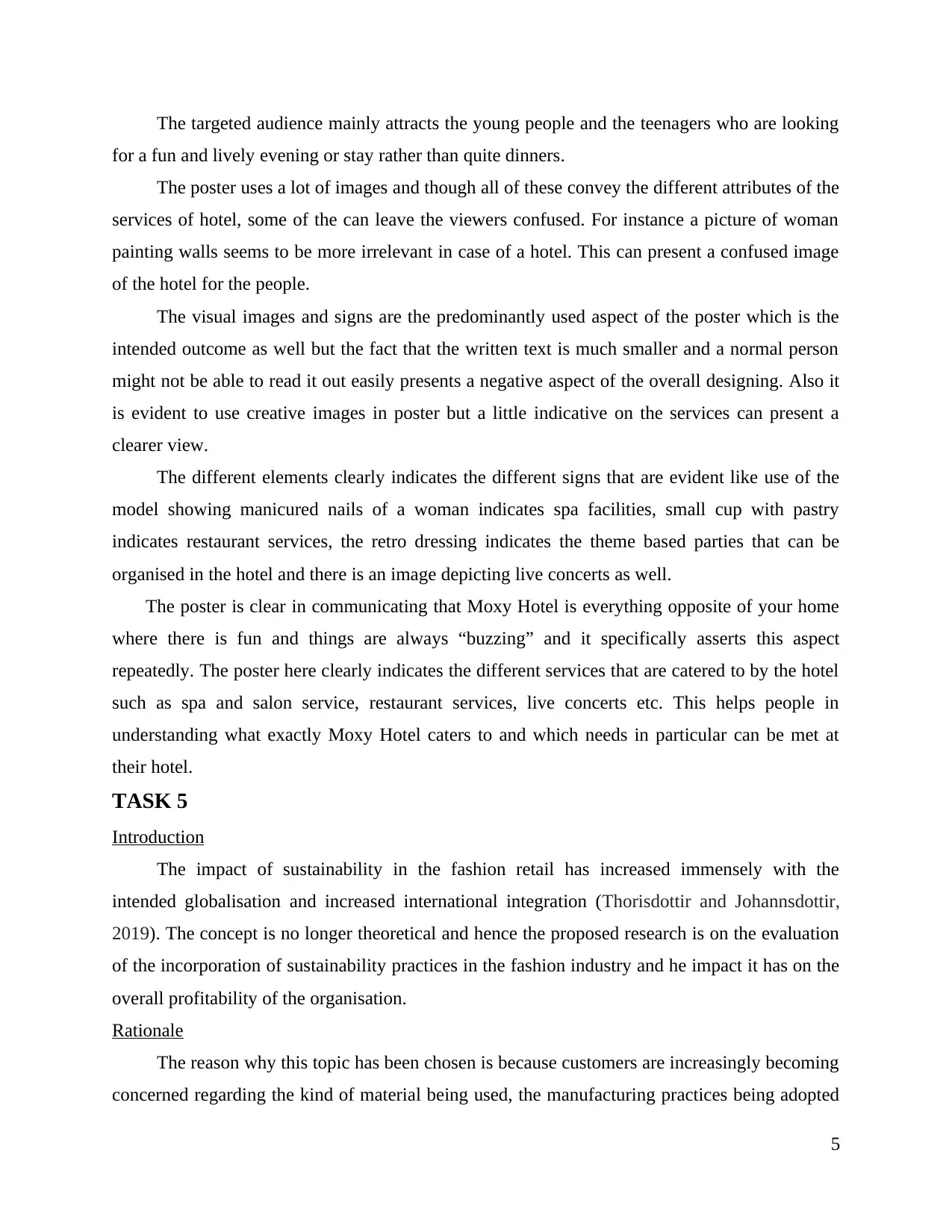
The targeted audience mainly attracts the young people and the teenagers who are looking
for a fun and lively evening or stay rather than quite dinners.
The poster uses a lot of images and though all of these convey the different attributes of the
services of hotel, some of the can leave the viewers confused. For instance a picture of woman
painting walls seems to be more irrelevant in case of a hotel. This can present a confused image
of the hotel for the people.
The visual images and signs are the predominantly used aspect of the poster which is the
intended outcome as well but the fact that the written text is much smaller and a normal person
might not be able to read it out easily presents a negative aspect of the overall designing. Also it
is evident to use creative images in poster but a little indicative on the services can present a
clearer view.
The different elements clearly indicates the different signs that are evident like use of the
model showing manicured nails of a woman indicates spa facilities, small cup with pastry
indicates restaurant services, the retro dressing indicates the theme based parties that can be
organised in the hotel and there is an image depicting live concerts as well.
The poster is clear in communicating that Moxy Hotel is everything opposite of your home
where there is fun and things are always “buzzing” and it specifically asserts this aspect
repeatedly. The poster here clearly indicates the different services that are catered to by the hotel
such as spa and salon service, restaurant services, live concerts etc. This helps people in
understanding what exactly Moxy Hotel caters to and which needs in particular can be met at
their hotel.
TASK 5
Introduction
The impact of sustainability in the fashion retail has increased immensely with the
intended globalisation and increased international integration (Thorisdottir and Johannsdottir,
2019). The concept is no longer theoretical and hence the proposed research is on the evaluation
of the incorporation of sustainability practices in the fashion industry and he impact it has on the
overall profitability of the organisation.
Rationale
The reason why this topic has been chosen is because customers are increasingly becoming
concerned regarding the kind of material being used, the manufacturing practices being adopted
5
for a fun and lively evening or stay rather than quite dinners.
The poster uses a lot of images and though all of these convey the different attributes of the
services of hotel, some of the can leave the viewers confused. For instance a picture of woman
painting walls seems to be more irrelevant in case of a hotel. This can present a confused image
of the hotel for the people.
The visual images and signs are the predominantly used aspect of the poster which is the
intended outcome as well but the fact that the written text is much smaller and a normal person
might not be able to read it out easily presents a negative aspect of the overall designing. Also it
is evident to use creative images in poster but a little indicative on the services can present a
clearer view.
The different elements clearly indicates the different signs that are evident like use of the
model showing manicured nails of a woman indicates spa facilities, small cup with pastry
indicates restaurant services, the retro dressing indicates the theme based parties that can be
organised in the hotel and there is an image depicting live concerts as well.
The poster is clear in communicating that Moxy Hotel is everything opposite of your home
where there is fun and things are always “buzzing” and it specifically asserts this aspect
repeatedly. The poster here clearly indicates the different services that are catered to by the hotel
such as spa and salon service, restaurant services, live concerts etc. This helps people in
understanding what exactly Moxy Hotel caters to and which needs in particular can be met at
their hotel.
TASK 5
Introduction
The impact of sustainability in the fashion retail has increased immensely with the
intended globalisation and increased international integration (Thorisdottir and Johannsdottir,
2019). The concept is no longer theoretical and hence the proposed research is on the evaluation
of the incorporation of sustainability practices in the fashion industry and he impact it has on the
overall profitability of the organisation.
Rationale
The reason why this topic has been chosen is because customers are increasingly becoming
concerned regarding the kind of material being used, the manufacturing practices being adopted
5
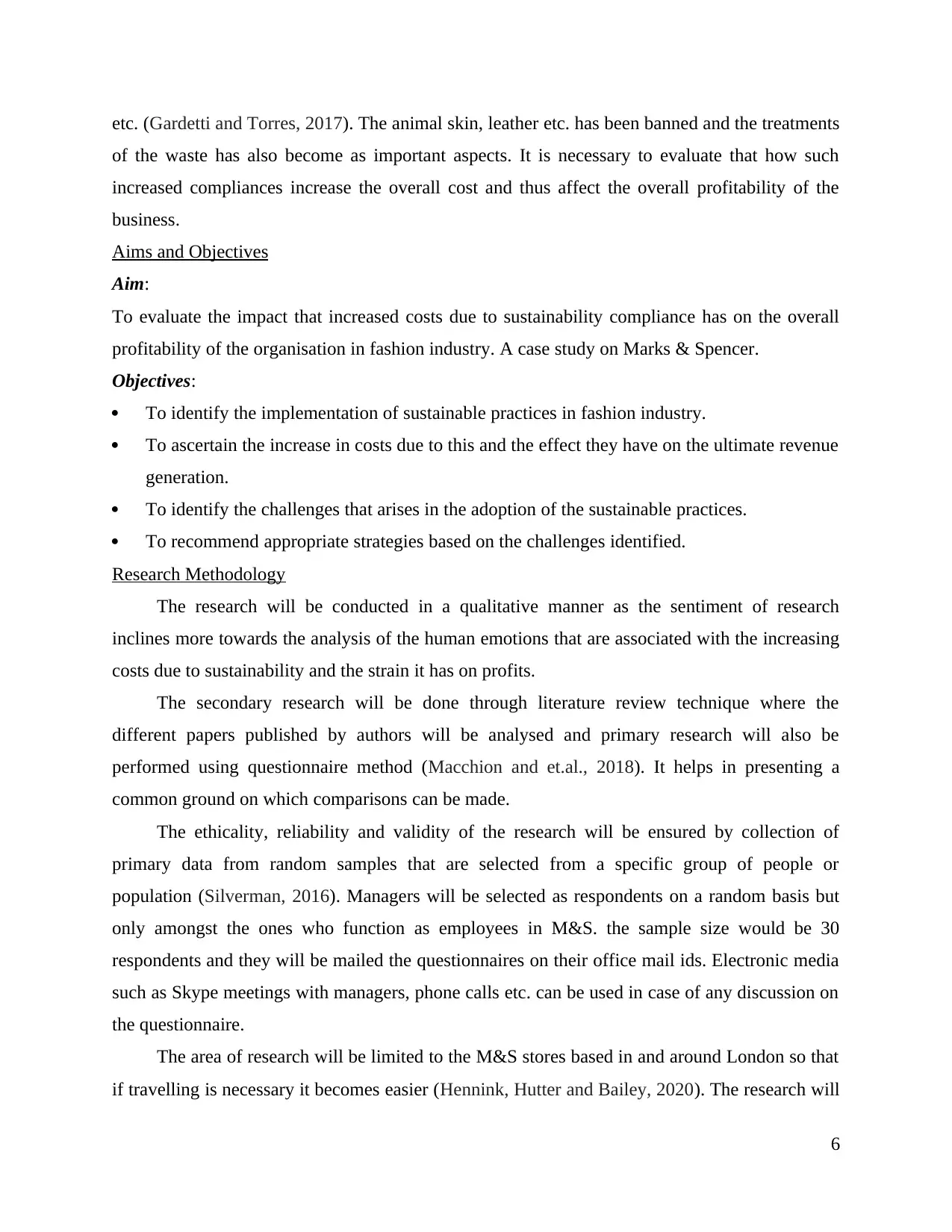
etc. (Gardetti and Torres, 2017). The animal skin, leather etc. has been banned and the treatments
of the waste has also become as important aspects. It is necessary to evaluate that how such
increased compliances increase the overall cost and thus affect the overall profitability of the
business.
Aims and Objectives
Aim:
To evaluate the impact that increased costs due to sustainability compliance has on the overall
profitability of the organisation in fashion industry. A case study on Marks & Spencer.
Objectives:
To identify the implementation of sustainable practices in fashion industry.
To ascertain the increase in costs due to this and the effect they have on the ultimate revenue
generation.
To identify the challenges that arises in the adoption of the sustainable practices.
To recommend appropriate strategies based on the challenges identified.
Research Methodology
The research will be conducted in a qualitative manner as the sentiment of research
inclines more towards the analysis of the human emotions that are associated with the increasing
costs due to sustainability and the strain it has on profits.
The secondary research will be done through literature review technique where the
different papers published by authors will be analysed and primary research will also be
performed using questionnaire method (Macchion and et.al., 2018). It helps in presenting a
common ground on which comparisons can be made.
The ethicality, reliability and validity of the research will be ensured by collection of
primary data from random samples that are selected from a specific group of people or
population (Silverman, 2016). Managers will be selected as respondents on a random basis but
only amongst the ones who function as employees in M&S. the sample size would be 30
respondents and they will be mailed the questionnaires on their office mail ids. Electronic media
such as Skype meetings with managers, phone calls etc. can be used in case of any discussion on
the questionnaire.
The area of research will be limited to the M&S stores based in and around London so that
if travelling is necessary it becomes easier (Hennink, Hutter and Bailey, 2020). The research will
6
of the waste has also become as important aspects. It is necessary to evaluate that how such
increased compliances increase the overall cost and thus affect the overall profitability of the
business.
Aims and Objectives
Aim:
To evaluate the impact that increased costs due to sustainability compliance has on the overall
profitability of the organisation in fashion industry. A case study on Marks & Spencer.
Objectives:
To identify the implementation of sustainable practices in fashion industry.
To ascertain the increase in costs due to this and the effect they have on the ultimate revenue
generation.
To identify the challenges that arises in the adoption of the sustainable practices.
To recommend appropriate strategies based on the challenges identified.
Research Methodology
The research will be conducted in a qualitative manner as the sentiment of research
inclines more towards the analysis of the human emotions that are associated with the increasing
costs due to sustainability and the strain it has on profits.
The secondary research will be done through literature review technique where the
different papers published by authors will be analysed and primary research will also be
performed using questionnaire method (Macchion and et.al., 2018). It helps in presenting a
common ground on which comparisons can be made.
The ethicality, reliability and validity of the research will be ensured by collection of
primary data from random samples that are selected from a specific group of people or
population (Silverman, 2016). Managers will be selected as respondents on a random basis but
only amongst the ones who function as employees in M&S. the sample size would be 30
respondents and they will be mailed the questionnaires on their office mail ids. Electronic media
such as Skype meetings with managers, phone calls etc. can be used in case of any discussion on
the questionnaire.
The area of research will be limited to the M&S stores based in and around London so that
if travelling is necessary it becomes easier (Hennink, Hutter and Bailey, 2020). The research will
6
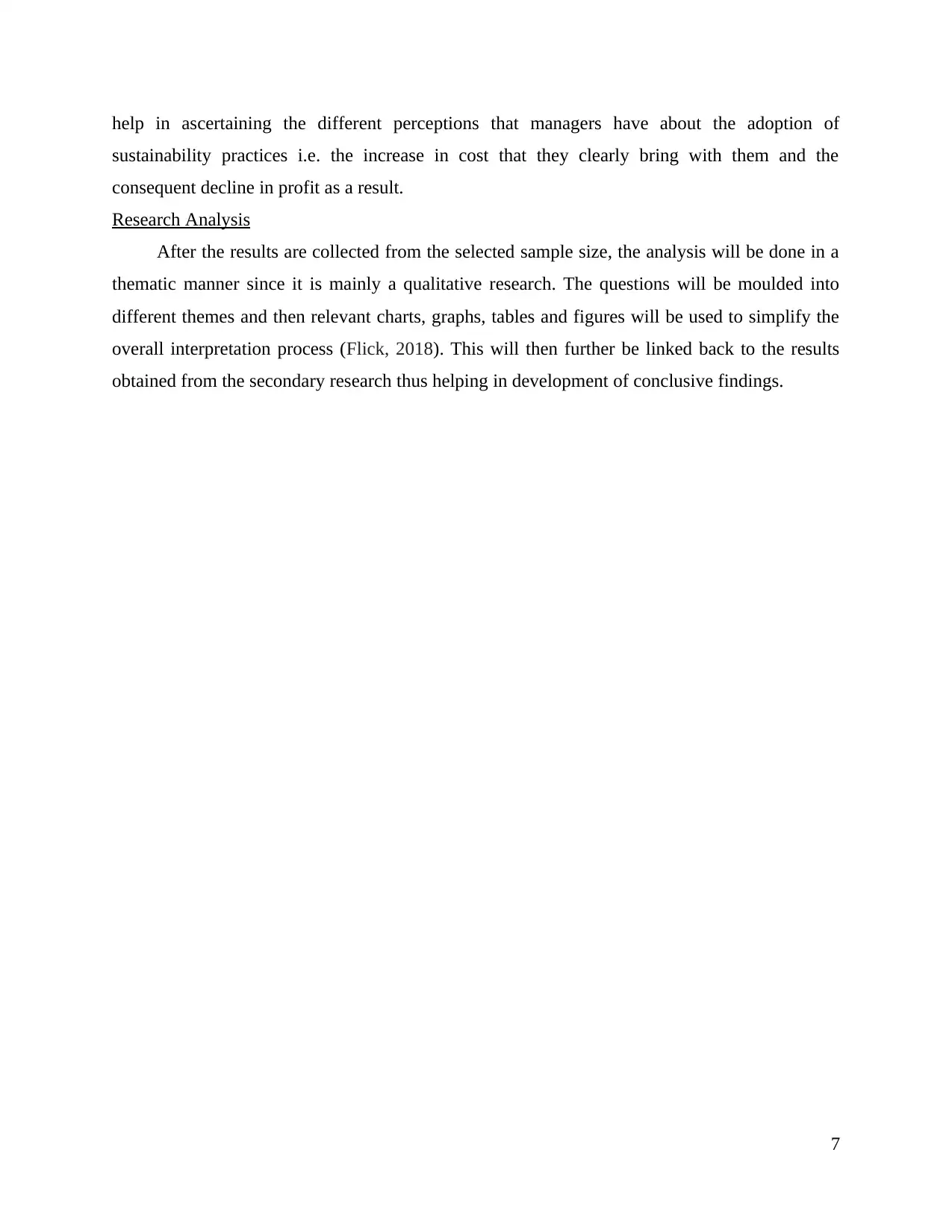
help in ascertaining the different perceptions that managers have about the adoption of
sustainability practices i.e. the increase in cost that they clearly bring with them and the
consequent decline in profit as a result.
Research Analysis
After the results are collected from the selected sample size, the analysis will be done in a
thematic manner since it is mainly a qualitative research. The questions will be moulded into
different themes and then relevant charts, graphs, tables and figures will be used to simplify the
overall interpretation process (Flick, 2018). This will then further be linked back to the results
obtained from the secondary research thus helping in development of conclusive findings.
7
sustainability practices i.e. the increase in cost that they clearly bring with them and the
consequent decline in profit as a result.
Research Analysis
After the results are collected from the selected sample size, the analysis will be done in a
thematic manner since it is mainly a qualitative research. The questions will be moulded into
different themes and then relevant charts, graphs, tables and figures will be used to simplify the
overall interpretation process (Flick, 2018). This will then further be linked back to the results
obtained from the secondary research thus helping in development of conclusive findings.
7
Paraphrase This Document
Need a fresh take? Get an instant paraphrase of this document with our AI Paraphraser
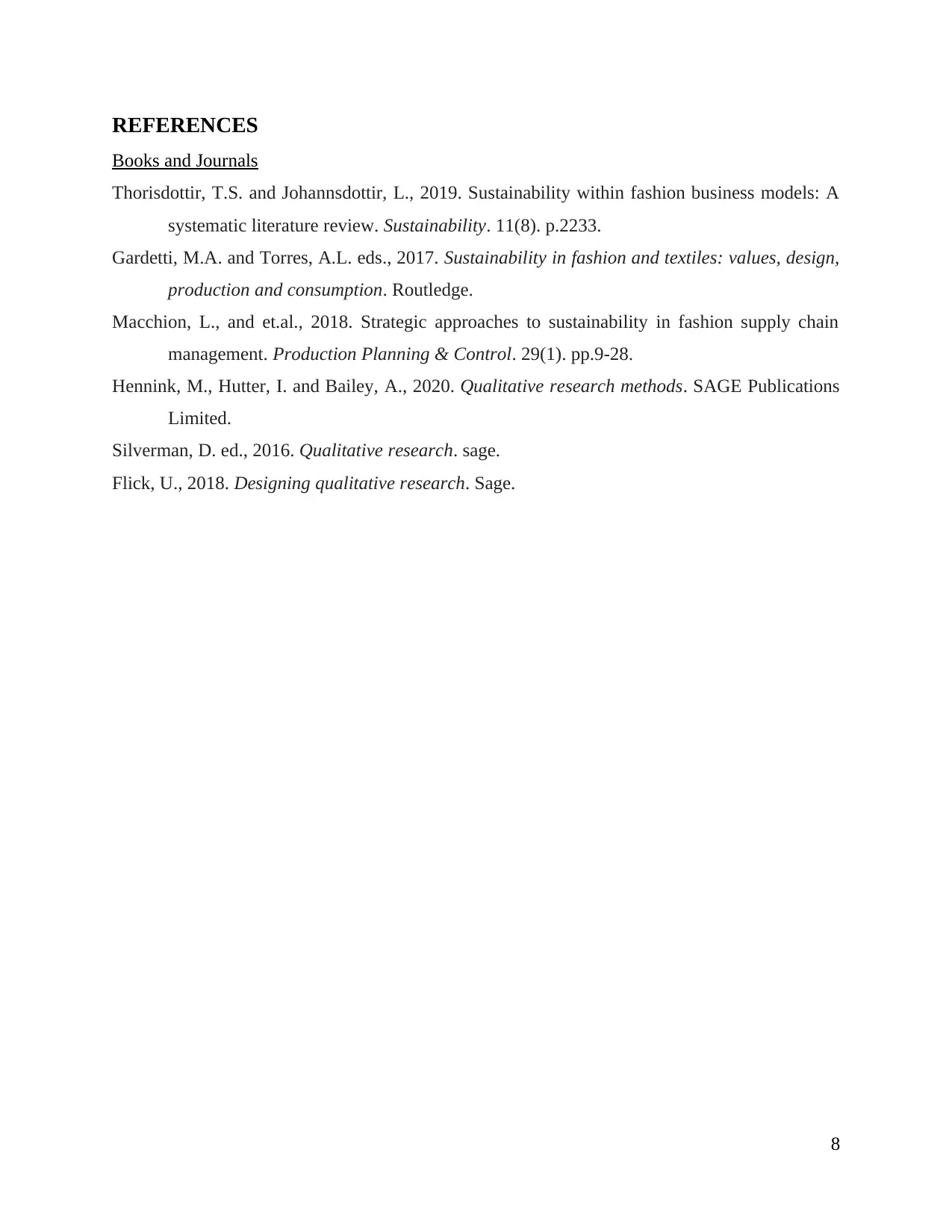
REFERENCES
Books and Journals
Thorisdottir, T.S. and Johannsdottir, L., 2019. Sustainability within fashion business models: A
systematic literature review. Sustainability. 11(8). p.2233.
Gardetti, M.A. and Torres, A.L. eds., 2017. Sustainability in fashion and textiles: values, design,
production and consumption. Routledge.
Macchion, L., and et.al., 2018. Strategic approaches to sustainability in fashion supply chain
management. Production Planning & Control. 29(1). pp.9-28.
Hennink, M., Hutter, I. and Bailey, A., 2020. Qualitative research methods. SAGE Publications
Limited.
Silverman, D. ed., 2016. Qualitative research. sage.
Flick, U., 2018. Designing qualitative research. Sage.
8
Books and Journals
Thorisdottir, T.S. and Johannsdottir, L., 2019. Sustainability within fashion business models: A
systematic literature review. Sustainability. 11(8). p.2233.
Gardetti, M.A. and Torres, A.L. eds., 2017. Sustainability in fashion and textiles: values, design,
production and consumption. Routledge.
Macchion, L., and et.al., 2018. Strategic approaches to sustainability in fashion supply chain
management. Production Planning & Control. 29(1). pp.9-28.
Hennink, M., Hutter, I. and Bailey, A., 2020. Qualitative research methods. SAGE Publications
Limited.
Silverman, D. ed., 2016. Qualitative research. sage.
Flick, U., 2018. Designing qualitative research. Sage.
8

9
1 out of 9
Related Documents
Your All-in-One AI-Powered Toolkit for Academic Success.
+13062052269
info@desklib.com
Available 24*7 on WhatsApp / Email
![[object Object]](/_next/static/media/star-bottom.7253800d.svg)
Unlock your academic potential
© 2024 | Zucol Services PVT LTD | All rights reserved.



